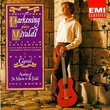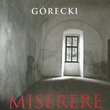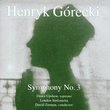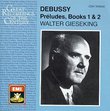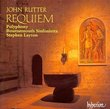| All Artists: Johannes Ockeghem, Pierre de Manchicourt, Giovanni Gabrieli, Allesandro Striggio Title: Utopia Triumphans Members Wishing: 3 Total Copies: 0 Label: Sony Release Date: 10/17/1995 Genres: Special Interest, Classical Style: Opera & Classical Vocal Number of Discs: 1 SwapaCD Credits: 1 UPC: 074646626122 |
Search - Johannes Ockeghem, Pierre de Manchicourt, Giovanni Gabrieli :: Utopia Triumphans
 | Johannes Ockeghem, Pierre de Manchicourt, Giovanni Gabrieli Utopia Triumphans Genres: Special Interest, Classical
A greatly expanded Huelgas Ensemble performs here a collection of multivoice works--pieces that are often referred to but, for logistical reasons, rarely performed. Tallis's famous Spem in alium non habui for 40 voices is ... more » |
Larger Image |
CD DetailsSynopsis
Amazon.com A greatly expanded Huelgas Ensemble performs here a collection of multivoice works--pieces that are often referred to but, for logistical reasons, rarely performed. Tallis's famous Spem in alium non habui for 40 voices is here, of course; so is the piece that inspired it, Striggio's 40-voice Ecce beatam lucem. Also included are two extraordinary canons: Ockeghem's 36-voice Deo gratias and Josquin's 24-voice Qui habitat--as well as relatively modest pieces for 13 to 16 voices by Porta and Gabrieli. Spem has had livelier performances (try the Tallis Scholars on Gimell), but none of the others have been recorded elsewhere at all, let alone as well as this. You're not likely to hear them in concert, either, so check this disc out. --Matthew Westphal Similarly Requested CDs
|
CD ReviewsImpressive hcf | 01/15/2000 (5 out of 5 stars) "This recording well matches its subtitle - "The great polyphony of the Renaissance." The multi-voice works collected here are indeed the pinnacle of vocal polyphony. I don't think anybody after Tallis wrote such complex music for an unaccompanied choir. From the first listen, I was struck by the similarities between Tallis' Spem and Striggio's Ecce Beatam Lucem. Turns out, as the booklet informs, the similarities were not accidental. Striggio was first to write his 40-part motet, and it had an extraordinary success in London. Piqued, the British fired back, by charging one of their best composers, Thomas Tallis, with the rebuttal (supposedly, the request came from the Duke of Norfolk). In the spirit of competition, Tallis deliberately included audible references to Striggio into his composition. These go beyond the choice of 40 voices (in fact, as far as I know, Spem is really for 41 voices, which is the way the Tallis Scholars perform it). The two compositions also share the same base key, G, an occasional melodic quote, and the technique of accumulating polyphony, in which voices enter one by one (or choir by choir) to culminate in mighty multi-person chords. Reportedly, upon hearing Tallis' Spem, the British concluded that their side won. Actually, I think so too. But maybe that's only because I heard Spem so many times before, and Ecce Beatam Lucem is new to me. The Huelgas Ensemble sing Spem with grace and balance. Their version seems much slower than the Spem of the Tallis Scholars, even though in fact the difference is only 15 seconds in a 10-minute piece (I checked). The perception of a slower tempo must be due to the reserved approach Van Nevel takes to Spem. I must confess that I much prefer the Tallis Scholars' jubilant rendition, with the dazzling treble voices reaching up like the spires of gothic cathedrals. The structural hierarchy of the piece is also more evident with the Tallis Scholars, who must have performed in less-reverberant acoustics: the entrance of voices and the brief pauses between some movements are more effective because they are not echoed. In addition, while the Huelgas recording has a constant fizz of consonants, the Tallis Scholars swallow most consonants, in a wise recognition that no one will be able to make any sense of the words in a 40-part vocal composition anyway. Not only is the blend smoother, but the result is also more consistent with the aesthetics of the day. Of course, this is not to criticize the Huelgas Ensemble, it's just my opinion. Of the other pieces on this disc I especially enjoyed Ockeghem's amazing 36-part canon Deo Gratias. Almost without varying the two-word canon, Ockeghem manages to sustain the listener's attention over a period of six minutes by manipulating the number and combination of singing voices. The disc also includes Giovanni Gabrieli's 16-part Exaudi me Domine. The group probably didn't know of the existence of Gabrieli's 33-part Magnificat, which would have been a nice addition to this disc. You can hear it on Music for San Rocco/McCreesh, Archiv 449 180-2." Outstanding recording esseyo | Jersey City, NJ United States | 02/09/2000 (5 out of 5 stars) "To clarify a previous reviewer, the Spem in Alium is for 40 voices (8 sopranos, 8 altos, 8 tenors, 16 basses) despite the fact that the Tallis Scholars used 41 singers (they doubled up on a soprano part which is surprising since the sopranos already completely dominate the sound in that recording). I personally prefer hearing audible consonants as in this recording because it allows one to hear the intricate rhythm of the piece ... it would be somewhat uninteresting to simply hear waves and waves of vowels as in the case of the Tallis Scholar recording. It is true the Hueglas Ensemble recording of the Spem has some understated sections but the voices are balanced and the singing is natural." One of the few essential recordings of Renassance polyphony Sator | Sydney, Australia | 05/28/2005 (5 out of 5 stars) "Paul van Nevel and the Heulgas Ensemble convey an intensely intimate yet ultimately powerful impression with this collection of gigantuan polyphonic works of mind boggling contrapunctal complexity. If you thought that some of Bach's four part counterpoint was exceedingly complex then try to get your mind around the fact that here you will find 12 voice, 24 voice - all the way up to 40 voice counterpoint! The audacity of such complexity is infinitely fascinating and utterly hypnotic. Though the mind may boggle in trying to follow the kaleidoscopic display of infinitely complex part writing, these are yet works of just enormous immediacy of emotional and spiritual appeal that makes them a far cry from the academic works they might seem to appear. These works are a testimony to the fact the composers of the Renaissance are every bit the equal of their peers in other arts such as painting and architecture, for in turns of the sheer phenomenal complexity of that these rich works display, the world has never since seen their equal.
The richer sounds of this continental European ensemble in comparison to the relentless purity of English groups is also highly welcome. As usual Paul van Nevel encourages a vocal sound that comes more from the chest giving a darker hued color that also has great expressive warmth. There is no attempt to artificially brighten up the upper registrars by doubling the soprano parts for example. In an age dominated by Cambridge style English cathedral style singing from groups which can sometimes start to sound all the same, it is wonderful to hear a group that dares to occupy so unique and distinctive a sound world as theirs. The Spem in Alium is a good case in point for the performance here is wonderful and quite unique. As for the claim that this performance of the 'Spem in Alium' is somehow weak, you can safely ignore that. Yes, the Tallis Scholars are still excellent too but there is a place for a less ostentatious and relaxed-intimate 'chamber' approach to this music. The performers even stood forming a circle in church to record these works. Warm and understated poetic intimacy are wonderful virtues that the Huelgas Ensemble always convey in abundance. In all this is one of the absolutely essential recordings of Renaissance polyphony. It is a must have for anyone who loves fine music and it you only own one recording of Renaissance polyphony this might well be it. It certainly has a firm place on my desert island collection." |

 Track Listings (7) - Disc #1
Track Listings (7) - Disc #1